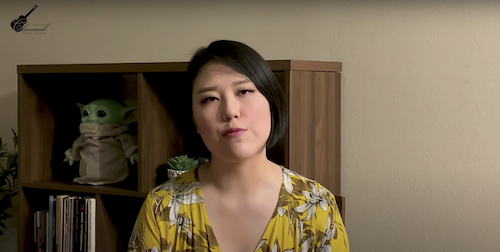by Jarrett Hoffman

The selections were an intriguing mix of old and new, and what was newest was the world premiere of a set of miniatures by Theo Chandler. His Six Melodies pull you in with their attractive lines, then stick in your brain with their riveting emotional complexity — expertly communicated by Byun.

Nuanced, conflicting emotions continue to reign as new techniques like harmonics and strumming make their way into the language of the piece, and as new contrasts play against each other: the fourth movement finds quivering tremolos suddenly transferring their energy over into speck-like harmonics. In the end, we look back on the opening material, now through a more distant lens — suspicious, almost corrupted — before being offered something small but positive to hold onto.
Two other examples of new on the program were a relatively unknown suite from a well-known composer (Mario Castelnuovo-Tedesco’s Escarraman) and the manuscript version of Manuel Ponce’s Theme, Variations, and Finale, less commonly performed than the Andrés Segovia edition.
Byun chose four of the six dances from Escarraman, and rearranged them cleverly: VI, III, IV, V. “La guarda cuydadosa” was a convincing opening with its brisk, purposeful tempo of “the soldier in love,” who later calms his forward march as romance takes over. “Pesame dello…” stood out with its quiet sadness and Byun’s alluringly mellow tone, and in this telling of the piece, “El rey Don Alonso el Bueno…” made for a warm and glorious ending. As for the rapid-fire articulations of “El villano,” Byun turned technical challenge into gestural beauty.
The Ponce was interesting to hear in its original form, which is less repetitious, brings in some variations that Segovia cut, and lays them out in a different order. Not all of those “extra” variations make a strong impact, but a few bring deeper feeling to the piece, especially in a sensitive performance like Byun’s.
Streamed concerts come with unique challenges of presentation. Here, individual movements were recorded separately, taking the listener a little bit out of the flow (something that can already be delicate when watching from home). Byun’s spoken introductions to each piece tended toward the dry side, especially considering her charming, conversational style when working with students of the Guitar Society in an included clip, and during my interview with her earlier this month.
That said, Byun’s last words were personal and quite touching. Before playing Agustín Barrios’ Un sueño en la floresta, she shared that it’s one piece that has helped her deal with her grandmother’s recent passing. Dedicating the performance to her, Byun went on to capture something supremely blissful, beautiful, and meaningful in this music.
Published on ClevelandClassical.com October 20, 2020.
Click here for a printable copy of this article




